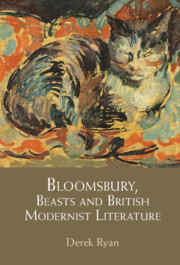Book contents
- Bloomsbury, Beasts and British Modernist Literature
- Frontispiece
- Bloomsbury, Beasts and British Modernist Literature
- Copyright page
- Dedication
- Contents
- Figures
- Acknowledgements
- Introduction
- Chapter 1 Leonard Woolf in the Jungle
- Chapter 2 David Garnett and Zoo Fictions
- Chapter 3 Virginia Woolf and Animal Biography
- Chapter 4 E. M. Forster’s Nonhuman Bundle
- Chapter 5 David Garnett, Flight and Earthly Creatures
- Coda
- Notes
- Bibliography
- Index
Chapter 5 - David Garnett, Flight and Earthly Creatures
Published online by Cambridge University Press: 01 December 2022
- Bloomsbury, Beasts and British Modernist Literature
- Frontispiece
- Bloomsbury, Beasts and British Modernist Literature
- Copyright page
- Dedication
- Contents
- Figures
- Acknowledgements
- Introduction
- Chapter 1 Leonard Woolf in the Jungle
- Chapter 2 David Garnett and Zoo Fictions
- Chapter 3 Virginia Woolf and Animal Biography
- Chapter 4 E. M. Forster’s Nonhuman Bundle
- Chapter 5 David Garnett, Flight and Earthly Creatures
- Coda
- Notes
- Bibliography
- Index
Summary
This chapter considers the associations between animality and aviation in the 1930s. It begins by explaining how Garnett’s reading of the Russian entomologist Boris Uvarov was crucial to his completion of his novel The Grasshoppers Come (1931), which contains such convincing depictions of insects that Uvarov suspected Garnett had viewed them first-hand (the letters Uvarov wrote to Garnett are here reproduced for the first time). Reading this novel alongside his diary-record of learning to fly, A Rabbit in the Air (1932), the first half of the chapter goes on to analyse how Garnett’s texts present an aesthetics of flight that hinges on connections and dissonances between human, animal and machine. The second part illustrates how Garnett’s aeronautical writing extended to the context of war and the publication of War in the Air (1941), which he wrote for the Air Ministry. By avoiding associations that had by the Second World War become bound up in nationalist bombast, Garnett subverts the increasingly masculinist and militarist approach to technology and animality found in other writings as the decade progressed.
- Type
- Chapter
- Information
- Bloomsbury, Beasts and British Modernist Literature , pp. 140 - 168Publisher: Cambridge University PressPrint publication year: 2022



